Fillings

The different types of filling
At the latest when they experience pain or larger holes in their teeth, most people make the often unpopular trip to the dentist....
Even the smallest hole in the tooth or a chipped corner should be repaired to prevent further destruction of the tooth. If the destruction of the tooth is still within certain limits and there is still enough tooth structure left, this is done with a filling. The aim is to restore the full functionality of the tooth as well as its natural shape and appearance.
But then the big question always arises. "...which material is the right one for me?". There is a wide range of different filling materials for both functional and financial reasons. At this point, we would like to give you a brief overview of the 3 most common types of filling in advance.
Of course, the right choice of material always depends on the size and location of the defect, as well as the specific situation and wishes of the individual and should be discussed individually!
We are happy to assist you with advice and support!
Our practice specializes in metal-free fillings
Fillings made of ceramic - closest to nature
Fillings made of ceramic ("Ceramic inlay") are superior to all other filling materials. Unlike other fillings, they are not plastic - i.e. initially soft - processed directly in the mouth, but are produced precisely and accurately in the dental laboratory after an impression has been taken. They do not change in the mouth and remain permanently stable. Unless the tooth develops a new cavity in another place or the filling did not fit properly from the start, the durability of the filling itself is unlimited. This means that there are always inlays that, with good oral hygiene, still look like they did on the first day even after 30 years!
The hardness also corresponds to that of the natural tooth, which ensures similar abrasion (wear) of the tooth and filling and thus the possible chewing load corresponds to that of the natural tooth. Large fillings or entire tooth cusps (partial crowns) can therefore also be replaced with inlays.

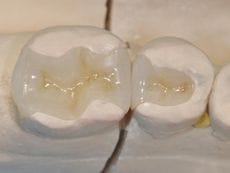

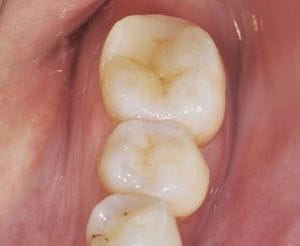
Although the costs are higher compared to other fillings due to the complex manufacturing process, they are cheaper over time due to their long shelf life.
As perfect imitations of nature - a kind of "artificial enamel" - ceramic inlays meet the highest standards in terms of aesthetics and lifelike shape. The result: even from a short distance, these inlays cannot be perceived as such.
For this reason, ceramic inlays are the method of choice for us today when esthetics and durability are important.
Plastic fillings - beautiful and affordable
For cosmetic reasons and because of its low cost compared to ceramics, tooth-colored plastic is the most commonly used filling material today (composite filling).
Due to its good esthetics, it is the method of choice especially in the anterior region. It is also a long-established standard procedure for smaller fillings
This seems to solve the question of a filling material to replace amalgam for the time being. Seems! Because after an average of three to six years, a medium-sized plastic filling in the posterior region that is subject to masticatory stress usually leaks again and has to be replaced. In this case, a little more healthy tooth substance always has to be sacrificed, so that the filling becomes larger each time and the problem becomes increasingly worse.
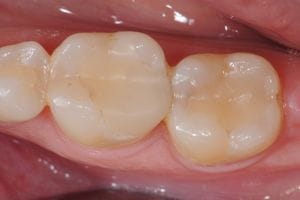
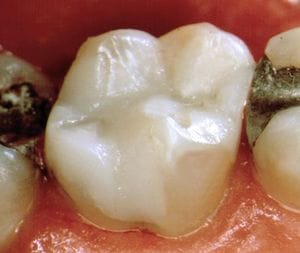

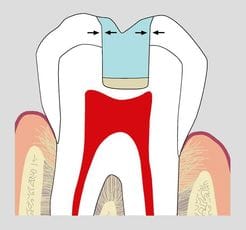
All resins are inserted into the tooth in a soft state and are subject to a certain amount of shrinkage when hardening. The following applies: the larger the filling, the more material, the greater the shrinkage. The filling material is therefore inserted into the tooth in different layers in order to minimize this shrinkage. However, it can rarely be completely avoided, which can lead to tension in the tooth (biting pain, sensitivity). Micro-gaps can also occur between the filling and the tooth, which can lead to leaky margins with early secondary caries (new caries under the filling).
Composite fillings are also inferior to other materials in terms of their susceptibility to wear. Despite modern ingredients such as glass or ceramic particles as volume fillers, they do not offer the necessary resistance to chewing forces, as the material is softer than the tooth substance. With large fillings, this leads to rapid abrasion of the fillings and subsequent changes in the occlusion.
For some patients, the ingredients may pose a problem in terms of intolerances and allergies. However, this can be checked in advance.
Fillings with amalgam - curse or blessing?
Even today, millions of teeth around the world still have amalgam fillings - a mixture of around 60% silver, 40% mercury and various other heavy metals such as copper and tin.
Like all plastic filling materials - i.e. materials that are inserted softly into the tooth and only harden there - amalgam does not remain stable in the long term, but is subject to various changes in the mouth. In the case of amalgam, corrosion is the main cause, which can lead to leaking filling edges, the ingress of bacteria and, as a result, to renewed caries ("secondary caries"). It is also common for entire tooth walls or cusps to break off due to stresses in the tooth. Nevertheless, with an average service life of 9 - 20 years (in individual cases even up to 30 years), it still has the longest durability compared to other plastic filling materials such as plastics.
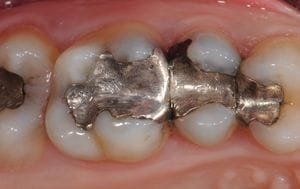
Due to the health concerns about its ingredient mercury, amalgam only plays a minor role and is therefore no longer used in our practice!
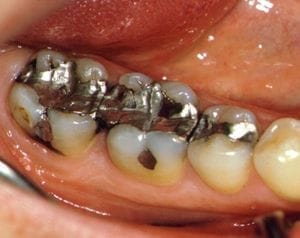
In particular, people who have several different metals in their mouth (such as gold and amalgam) have increased mercury levels in their body, as mercury ions can be released from the amalgam due to electrochemical corrosion (battery effect) in the mouth. In addition to mercury, other heavy metals such as copper or tin also enter the body through abrasion (abrasion of the teeth under function) and are deposited primarily in fatty and nerve tissue. This is where they can develop their neurotoxic effect.
Amalgam can trigger many secondary diseases, which can break out sooner or later depending on the physical condition or degree of exposure. In particular, many chronic and initially almost imperceptible illnesses are attributed to amalgam.
Allergies, immune deficiency, anemia, depression, asthma, headaches, anxiety, intestinal diseases, skin eczema, neurodermatitis, memory disorders, joint pain, cardiac arrhythmia, liver and kidney damage and much more.
Dr. Jens Tartsch

